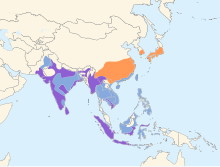Middle heron
| Middle heron | ||||||||||||
|---|---|---|---|---|---|---|---|---|---|---|---|---|

Middle Heron ( Ardea intermedia ) |
||||||||||||
| Systematics | ||||||||||||
|
||||||||||||
| Scientific name | ||||||||||||
| Ardea intermedia | ||||||||||||
| Wagler , 1827 |
The Intermediate Egret ( Ardea intermedia , Syn. : Mesophoyx intermedia ) is a bird art from the family of herons . It is a slender, pure white species of heron with a long neck and dark legs. The distribution area of the middle heron is Africa, Southeast Asia and Australia.
features
The middle heron is a medium-sized heron with white plumage . The body length is 56 to 70 centimeters. The head and neck make up about half of it. Middle-herons weigh an average of 400 grams.
He is from egrets to distinguish good, because it is much smaller. It differs from the little egret of roughly the same size by its yellow beak. In flight it can be recognized by the fact that its relatively short legs protrude less than the tail than other heron species.
Occurrence
Its large area of distribution includes the tropics from eastern Africa through southern and eastern Asia to Australia and Japan . He is a stray visitor in Tasmania and New Zealand. Its habitat are wetlands and shallow coastal waters , but also flooded rice fields. Very rarely does he stay on the coast.
behavior
Standing in the shallow water, it hunts for fish , crustaceans and insects . It usually stays in water below 8 centimeters and prefers to look for food in water regions that are densely overgrown. He seeks his food by stalking prey motionless or by walking slowly forward.
The nests usually consist of branches and twigs and are built on trees and bushes near the water. There it nests in loose colonies, often in the company of other heron species. The colonies can be very large. In Kakadu National Park, Australia, two colonies had 1,800 and 3,000 to 4,000 nests, respectively. The nests are flat platforms made of dry and fresh twigs, only loosely joined together. Both parent birds are involved in the construction. The brood consists of two to five eggs. The clutch is incubated by both adult birds and the young birds are also raised by both parents.
supporting documents
literature
- Bernhard Grzimek: Grzimeks animal life. Munich 1993.
- Bikram Grewal: Birds in India and Nepal. Giessen 2000.
- Hermann Heinzel u. a .: Parey's bird book. All birds of Europe, North Africa and the Middle East. Berlin 1992.
- PJ Higgins (Ed.): Handbook of Australian, New Zealand & Antarctic Birds , Volume 1, Ratites to Ducks, Oxford University Press, Oxford 1990, ISBN 0195530683
Web links
- Videos, photos and sound recordings of Egretta intermedia in the Internet Bird Collection
- Mesophoyx intermedia in the endangered Red List species the IUCN 2008. Posted by: BirdLife International, of 2008.


